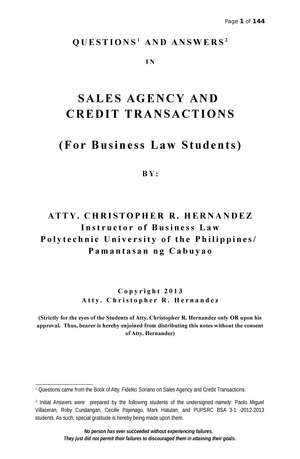- Information
- AI Chat
Was this document helpful?
05-23-2022 CRC-ACE - AFAR - Week 01 Accounting for Partnership - Part 1 Operations
Course: BS accountancy
999+ Documents
Students shared 13151 documents in this course
University: University of Cebu
Was this document helpful?

ADVANCED FINANCIAL ACCOUNTING & REPORTING PROF. ROEL E. HERMOSILLA
WEEK 1 - ACCOUNTING FOR PARTNERSHIP
PARTNERSHIP OPERATIONS
Allocation of Partnership Income (Loss)
The partners should have a written agreement, called articles of co-partnership, specifying the
manner in which partnership income (loss) is to be distributed. Note that in the absence of a
predetermined agreement, the profit and loss (P&L) is divided according to original capital contributed
by partners.
A number of issues arise which complicate the allocation of partnership income (loss).
1. Partners may receive interest on their capital balances. If so, it must be determined what
constitute the capital balance (e.g., the year-end amount of some type of weighted-average).
2. Some of the partners may receive a salary.
3. Some of the partners may receive a bonus on distributable net income. If so, you need to
determine if the bonus should be computed before or after salary, interest and bonus allocations.
4. A formula needs to be determined for allocating the remaining income. The formula agreed upon
is usually termed the residual, remainder, or profit (loss) sharing ratio.
Finally, the partners should decide upon how income is to be allocated if net income is insufficient to
cover partner’s salaries, bonuses, and interest allocations. These allocations are usually made even if the
effect is to create a negative remainder. This is important to note that partners may choose to allocate
losses (or a negative remainder) in a different manner than income.
Example: Partnership P & L Distribution
A, capital P300,000; B, capital P100,000; and C, capital P50,000
Partners receive 5% interest on beginning capital balances
Partner B receives a P60,000 salary
Partner C receives a 10% bonus after interest and salaries
The P&L ratios are A – 50%; B – 30%; C – 20%
Assuming partnership net income of P182,500, the distribution schedule would be prepared:
A
B
C
Total
5% interest on beginning capital
P15,000
P 5,000
P 2,500
P 22,500
Salary to partner B
60,000
60,000
Bonus to partner C after interest &
salaries
10,000*
10,000
Remaining distribution 50:30:20:
45,000
27,000
18,000
90,000
Total share
P60,000
P92,000
P30,500
P182,500
*(P182,500 – P22,500 – P60,000) x .10 = P10,000
Note that if the interest, salary, and bonus allocation had exceeded net income, the excess would
have been deducted on the distribution schedule in the P&L ratio.
Note also, that if the bonus is based on net income after interest, salary and bonus then, bonus
would have been computed as follows: P182,500 – P22,500 – P60,000 divided by 110% x 10%.
Sometimes, problems in the CPA board exam will require the examinee to determine first the net
income before allocation is made. In this case, the method of determining net income must first be
determined in order to compute the distributed net income. If the problem is silent as to the method
used, then the generally accepted method must be the accrual basis of accounting net income.
T
Th
he
e
P
Pr
ro
of
fe
es
ss
si
io
on
na
al
l
C
CP
PA
A
R
Re
ev
vi
ie
ew
w
S
Sc
ch
ho
oo
ol
l
Davao
3/F GCAM Bldg. Monteverde St. Davao City
0917-1332365
Baguio
2nd Flr. #12 CURAMED Bldg. Marcos Highway, Baguio City
0906-0775156 / 09618683385
Main: 3F C. Villaroman Bldg. 873 P. Campa St. cor Espana, Sampaloc, Manila
(02) 8735 8901 / 0917-1332365
email add: crc_ace@yahoo.com/crcacemanila.onlineenrollment@gmail.com











